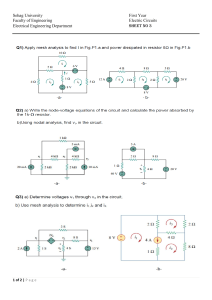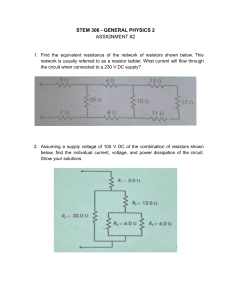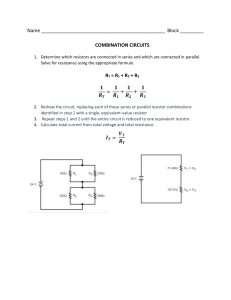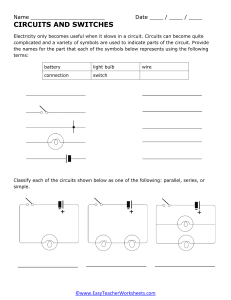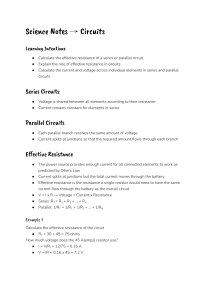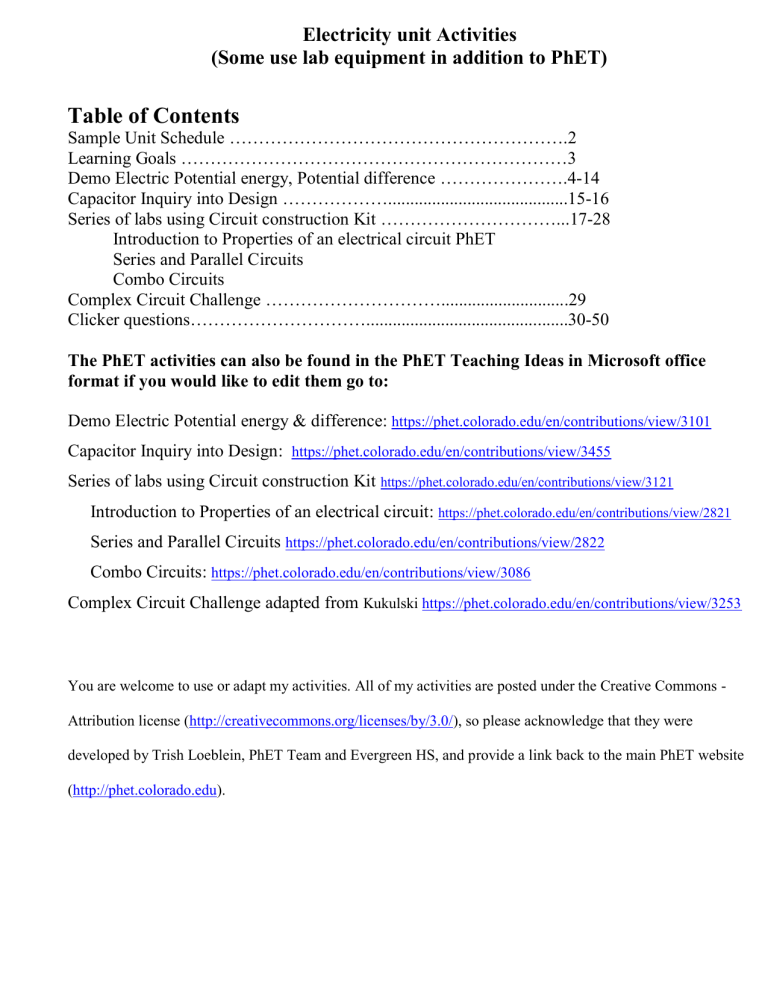
Electricity unit Activities (Some use lab equipment in addition to PhET) Table of Contents Sample Unit Schedule ………………………………………………….2 Learning Goals …………………………………………………………3 Demo Electric Potential energy, Potential difference ………………….4-14 Capacitor Inquiry into Design ……………….........................................15-16 Series of labs using Circuit construction Kit …………………………...17-28 Introduction to Properties of an electrical circuit PhET Series and Parallel Circuits Combo Circuits Complex Circuit Challenge ………………………….............................29 Clicker questions…………………………..............................................30-50 The PhET activities can also be found in the PhET Teaching Ideas in Microsoft office format if you would like to edit them go to: Demo Electric Potential energy & difference: https://phet.colorado.edu/en/contributions/view/3101 Capacitor Inquiry into Design: https://phet.colorado.edu/en/contributions/view/3455 Series of labs using Circuit construction Kit https://phet.colorado.edu/en/contributions/view/3121 Introduction to Properties of an electrical circuit: https://phet.colorado.edu/en/contributions/view/2821 Series and Parallel Circuits https://phet.colorado.edu/en/contributions/view/2822 Combo Circuits: https://phet.colorado.edu/en/contributions/view/3086 Complex Circuit Challenge adapted from Kukulski https://phet.colorado.edu/en/contributions/view/3253 You are welcome to use or adapt my activities. All of my activities are posted under the Creative Commons Attribution license (http://creativecommons.org/licenses/by/3.0/), so please acknowledge that they were developed by Trish Loeblein, PhET Team and Evergreen HS, and provide a link back to the main PhET website (http://phet.colorado.edu). High School Physics Electricity Current, Resistance, Circuits, and Circuit Elements What is electric current? What is electric resistance? How do electric circuits behave? Can you build circuits? I designed this unit to be flexible for students’ varied skills. During this unit, student groups do each lab at different rates; all the equipment is available. The unit schedule is only a guideline to help students. I explain and encourage students to complete the labs before the clicker questions. They must complete the lab practical and test by the dates provided Day 1 Notes: Electric Potential energy, Potential difference and Capacitance Lab1: Capacitor Lab: Inquiry into Capacitor Design Do: read text, Concept questions, Practice problems Day 2 Notes: Measurement tools and current Lab2: Introduction to Properties of an electrical circuit PhET Do: read text, Concept questions, Practice problems Day 3 Notes: Resistance and Ohm’s Law (after lab) Lab2: Finish Introduction lab Do: read text, Concept questions, Practice problems Day 4 Lab3: Series and Parallel circuits PhET Day 5 Notes: Power, Schematic diagrams, Clicker questions 1 Lab3: Series and Parallel circuits PhET Do: read text, Concept questions, Practice problems Day 6 Notes: Resistors in series and parallel Do: read text, Concept questions, Practice problems Day 7 Notes: Resistors in combo circuits, Clicker questions 2 Do: read text, Concept questions, Practice problems Day 8 Notes: Household Electricity Lab4: Combo circuits PhET Do: read text, Practice problems Day 9 Lab5: Complex Circuit Challenge PhET Review study & test taking skills; some students do Lab practical test Do: read and do text problems, questions and standardized testing practice Day 10 Review All students must have completed: Lab practical test Day11 Test 7/19/2013 High School Physics Electricity Current, Resistance, Circuits, and Circuit Elements What is electric current? What is electric resistance? How do electric circuits behave? Can you build circuits? Learning Goals: Students will be able to Charges and Fields: Solve the textbook problems after an introduce to Electric Energy and Capacitance Identify the variables that affect the capacitance and how each affects the capacitance. Determine the relationships between charge, voltage, and stored energy for a capacitor. Relate the design of the capacitor system to its ability to store energy. Introduction to Properties of Electric Circuits PhET Activity Discuss basic electricity relationships Analyze the differences between real circuits and the simulated ones Build circuits from schematic drawings Use a multi-meter to take readings in circuits Provide reasoning to explain the measurements and relationships in circuits Resistors in Series and Parallel Circuits PhET Activity Discuss basic electricity relationships in series and parallel circuits Analyze the differences between real circuits and the simulated ones Build circuits from schematic drawings Use a multi-meter to take readings in circuits Combo Circuits PhET Activity Analyze the differences between real circuits and the ideal ones Build circuits from schematic drawings Use a multi-meter to take readings in circuits Provide reasoning to explain the measurements in circuits Other goals that I would include in homework and class discussions (These are adapted from College Physics: A Strategic Approach First Edition, by Knight, Jones, Field. Pearson 2007) Describe the basic properties of electric current Solve problems relating current, charge, and time Describe models for circuits on an atomic level Differentiate between direct current and alternating current Calculate resistance, current, and potential difference using the definition of resistance Distinguish between ohmic and non-ohmic materials (theorectical vs real systesms) Know what factors affect resistance Relate electric power to the rate at which electrical energy is converted to other forms of energy Calculate electric power Calculate the cost of running electrical appliances Interpret and construct circuit diagrams Identify circuits as open or closed Deduce the potential difference across the circuit load, given the potential difference across the battery's terminals Calculate the equivalent resistance for a circuit of resistors in series, and find the current in and potential difference across each resistor in the circuit Calculate the equivalent resistance for a circuit of resistors in parallel, and find the current in and potential difference across each resistor in the circuit Calculate the equivalent resistance for a complex circuit involving both series and parallel portions Calculate the current in and potential difference across individual elements within a complex circuit 7/19/2013 Lesson plan for Charges and Fields : Demonstration to help with PE vs V Time for activity 25 minutes Learning Goals: This is a lecture demonstration meant to introduce Electric Energy and Capacitance, so that the students will be able to solve the textbook problems. Background: I used this as an intro to the Electricity unit which has a focus on circuits, the previous unit included Static charge and magnetism. Charges and Fields: If you grab a charge and don’t let go you can emulate a charge moving through a field, but the field is not uniform. Lesson: I made a slide presentation to use, but I included some of the notes here too. Notes from text: PEelectric = -qEd (charge x electric field strength x displacement from a reference point in the direction of the field) [joules = coulombs x newtons/coulomb x meters] Potential energy increases for a negative charge and decreases for a positive one. Only the displacement parallel to the field effects the energy like gravitational potential energy is only effected by vertical displacement. J Nm V N V E can also be measured in C C m C m m m J PE= -qEd [unit analysis: J= C C m m I used the PhET sim to demonstrate a charge moving through a field even though you cannot make a uniform field. You can show E field with direction only so that the arrows are all dark red; I put one negative charge to help remind the students that field points towards negative. If you grab a charge and drag it without letting go, it won’t change the field like a small charge in a relatively large uniform field would. If you build the circuit with the default values, the capacitor will charge almost instantaneously, but I found that using about 3 v slows it down enough to be helpful. 7/19/2013 Loeblein http://phet.colorado.edu Chapter 18 Electric Energy and Capacitance demonstrations Electric Potential Energy • ΔPE= -qEΔd • PEelectric= -qEd charge ∗ electric field strength ∗ displacement from a reference point in the direction of the field •Only for a uniform field •Another type of Mechanical Energy Positive charge moves d through a uniform field E + + d Figure 18-2 from p667 Potential Energy: Electric vs Gravity ΔPEelectric = -qE Δ d Δ PEgravity = mg Δ h m h d earth Unit analysis PE= -qEd • joules = coulombs ∗ newtons/coulomb∗ meters J = Nm so N J = C ∗ ∗m C • E is sometimes in V m so and J J = C ∗ C ∗m m J V= C Potential Difference • Potential difference is the change in electric potential measured in volts • ΔV = ΔPEelectric Units: volts=J/C q V • ΔV=-E Δd Units: volts= *m m Potential Difference in Charges and Fields sim -4.4 V 2.2 V/m Capacitors • Device that stores charge • Capacitance is a measure of the ability to store energy in the form of separated charges Capacitance Equations Q C= ΔV Q = total charge A C = ε0 d ε0 = permittivity constant (C2/Nm2) Units: farads = C/V A = area of plate d = Distance between plates Energy and Capacitors Equations 1 PE = QΔV 2 1 2 PE = C ( ΔV ) 2 2 Q PE = 2C Lesson plan for Capacitor Lab: Inquiry into Capacitor Design http://phet.colorado.edu Learning Goals: Students will be able to: Identify the variables that affect the capacitance and how each affects the capacitance. Determine the relationships between charge, voltage, and stored energy for a capacitor. Relate the design of the capacitor system to its ability to store energy. Learning Goals for Capacitor Lab Advanced Activity: (I have not written an activity for these goals yet, because they are not part of my course. These learning goals would be addressed using the third tab: Multiple Capacitors and perhaps the PhET Circuit Construction Kit AC-DC) Determine the equivalent capacitance of a set of capacitors in series and in parallel in a circuit. Determine the energy stored in a set of capacitors in a circuit. Explore how varying the amount of dielectric material inserted between the conductors affects the function of the capacitor. Explain how a capacitor or set of capacitors would be used in a real world application. Background: My students will have completed a unit on static electricity and magnetism: http://jeffcoweb.jeffco.k12.co.us/high/evergreen/science/loeblein/phys_syl/Sem2Unit3.html. Capacitance is a small learning goal for Electricity unit, so I plan to assign this activity as homework after an introductory lecture. Capacitor Lab Introduction: This seems to be a very easy sim to allow students to explore without directions. There are no Tips for Teachers for this sim as of August 2011. Lesson: Students will do this for homework. Post-Lesson: At this time, I have not written clicker questions, but I think this is a good sim for probing students’ concepts with clickers. Follow-up sims: Circuit Construction Kit AC-DC has capacitors that students can use in circuits with other circuit components. 8/7/2011 Loeblein http://phet.colorado.edu Student directions Capacitor Lab: Inquiry into Capacitor Design Learning Goals: Students will be able to: Identify the variables that affect the capacitance and how each affects the capacitance. Determine the relationships between charge, voltage, and stored energy for a capacitor. Relate the design of the capacitor system to its ability to store energy. Directions: 1. Using the first 2 tabs variables that are used to design a capacitor. , voltmeter, and battery, find 2. Identify what you would maximize or minimize to make a capacitor with the greatest capacitance. Are there items in the sim that do not appear to affect the capacitance? 3. Using the first 2 tabs , voltmeter, and battery, explore the relationships between charge, voltage, and stored energy for a capacitor. Summarize your findings. 4. If you wanted to design a capacitor system to store the greatest energy, what would you use? 8/7/2011 Loeblein http://phet.colorado.edu Circuit Construction Kit (CCK) Lesson Plans A series of three labs, several days of class Learning Goals: Students will be able to Discuss basic electricity relationships: simple, series and parallel, and more complex Analyze the differences between real circuits and the simulated ones Build circuits from schematic drawings Use a multi-meter to take readings in circuits Provide reasoning to explain the measurements and relationships in circuits Background: We will have studied static electricity and talked about a general model of current. We talk about using a common model where the movement of large groups of electrons is from high PE to lower PE like water falling off a cliff. We discuss that this is just a simple model to help us make sense of the relationships. I often use the analogy of students running a cross-country race with using all the energy of one energy bar. Hill height, body mass, and speed are some things that they will see effect the outcome. The three labs are guided inquiry-based to prepare the students for the text readings and subsequent word problems. Circuit Construction Kit Introduction: I demonstrate how to use a real multi-meter. I show a battery being measured and hold up a real resistor. For the simulation, I only demonstrate that a real wire is not linear like ones in the simulation. I have tried using all the versions of CCK and prefer the DC only version. For the Teacher: Some basic skills for using CCK you might want to try these things yourself so you can help students with their difficulties: 1. 2. 3. 4. Adding parts Connecting parts with wires Deleting wires or parts to add parts. You can’t just add after the circuit is built. Using the voltmeter and ammeter. The non-contact ammeter is especially handy, but the other one is realistic. 5. The difference between schematic and lifelike views. In all my student directions, I plan to use schematics. 6. Clearing the image to start something else. 7. Using high voltage on may cause the system to freeze. Lesson: I have written a series of three labs for circuits. During the labs, students use both real equipment and the simulation. Sometimes, the simulation is used first to allow students to build their own ideas. Then, there are parts where they use real equipment and verify their answers with the simulation. Before the second lab, we will have a class discussion about resistance using the illustrations on our text and analogies. One analogy that I use: the students pretend they are trying to get to the office from a classroom. We talk about how hall size, distance to the office, congestion, size of students in the hall and whether or not they are moving effects the time and energy it takes to get there. (There are also versions of each activity that require only CCK) Post Lessons: I use concept questions that I have written aligned with each activity. I use personal response systems throughout the unit to check for skills and use the results to identify who needs some more help. 4/22/2011 Loeblein Some Properties of Electric Circuits (Uses CCK only ) Learning Goals: Students will be able to • Discuss basic electricity relationships • Build circuits from schematic drawings • Use an ammeter and voltmeter to take readings in circuits. • Provide reasoning to explain the measurements and relationships in circuits. I. Observing voltage relationships Go to the PHeT web site and use the Circuit Construction Kit simulation (CCK). Drag out three batteries. Measure the voltage of each using the voltmeter and record the voltage in a table like the one shown. Then move the batteries end to end as below to measure combined voltage. Battery Voltage (V) 1 1 2 1 1+2 2 2 3 1+2+3 3 1+2 1+2+3 a. Describe the relationship between the number of batteries and the voltage and explain what you think might be happening. b. What could you vary to test your description about the relationship? (Right click on the batteries to change characteristics ) Run several tests recording your data in an organized table. c. Talk to another group about their description, tests and results. Rewrite your description to include the more broad tests. II. Using voltage Use the Circuit Construction Kit simulation to build a circuit with a battery and a light bulb in the Lifelike visual mode. a. Draw what your circuit looks like. b. How does the voltage of the battery compare to the light bulb voltage? Explain what you think is happening. c. Vary the voltage of the battery and write observations about how the brightness is affected by voltage. d. Think about a real light bulb and battery; explain what you think is happening that causes the changes in brightness. III. Using voltage in series circuits Use CCK to build the circuits below with a battery at about 12 volts and light bulbs. Turn on the voltmeter and ammeter to measure voltage of the battery and current into it. Record bulb brightness with descriptive language. Figure 1 Figure 2 Figure 3 # of bulbs Battery voltage (v) Current into battery(A) Brightness of bulbs 1 2 3 a. a. b. c. d. Summarize the relationships you observed and explain what you think is happening. Test to see if changing the battery voltage causes you to modify any of your conclusions. Explain what you measured and any conclusions you draw from your tests. What happens when you take a wire out of a circuit? Explain what you think is happening Test using the voltmeter or ammeter in different ways. For example: Does it matter if you take the reading on the left or right of the battery? Switch the meter ends? Describe your tests and results. 11/3/2008 Loeblein 1 Some Properties of Electric Circuits (Uses CCK only ) IV. Using voltage in parallel circuits Redo Part III but use figures 4-6 for the circuits. Make a new table and answer the questions. Figure 4 Figure 5 Figure 6 V. Observing voltage and current relationships with resistors Use CCK to build the circuit below. Vary the voltage of the battery. Record the battery voltage and the current in the circuit in a table. V A a) Explain what might be happening to cause the change in current. b) How are current and battery voltage related? What is the shape of the graph? c) Describe how you could use the simulation to verify the relationship. Test your ideas and make modifications to your original answers if necessary. Be sure to explain your reasoning. VI. Observing voltage and current relationships for variable resistors. Build the circuit below. Vary the value of resistor at least ten times. Record in a data table: resistance, current and voltage for each trial. A V a) Chart and determine the algebraic relationship for resistance and current. b) Chart and determine the algebraic relationship for resistance and voltage. c) Explain the relationships in terms what you think is happening in the circuit. Include how this experiment is like the one where you added light bulbs. 11/3/2008 Loeblein 2 Resistors in Series and Parallel Circuits (Using CCK simulation) Learning Goals: Students will be able to • Discuss basic electricity relationships in series and parallel circuits • Build circuits from schematic drawings • Use voltmeters and ammeters to take readings in circuits. • Provide reasoning to explain the measurements in circuits. I. Series Circuit Construct the circuit figure 1 using The Circuit Construction Kit (CCK) simulation at the PHeT site. Make the resistors have different value and record the value of each resistor. Use the ammeter moving it to take readings in the different places seen in figure 2. Then use the voltmeter to take voltage readings. Calculate R using Ohm’s Law (V=IR) for the total resistance in last column. Figure 2 VT Figure 1 At A1 V1 Resistor 1 2 3 Total A3 A2 Voltage(V) Current (A) Resistance (Ω) VT reading AT reading RT=VT/IT V2 V3 a. How is the total resistance related to the individual resistances? Total current to the individual currents? Total voltage to the individual voltages? b. Write a paragraph explaining what you think is happening in series circuits to cause the above relationships to occur. (You made a similar circuit with light bulbs using CCK. You may want to experiment with the sim again, keeping in mind that light bulbs are just resistors that glow.). 11/3/08 1 Resistors in Series and Parallel Circuits (Using CCK simulation) II. Parallel Circuits Wire the circuit in figure 1 with the same value resistors that you used in Part 1. Take readings in different places shown in figure 2 by moving the meters. Make a table like the one below, calculating total resistance using Ohm’s Law (V=IR) for the last column. Resistor Voltage (V) Current(A) Resistance(Ω) 1 2 3 Total VT reading AT reading RT=VT/IT VT A1 AT R V Figure 2 R Figure 1 V R A A2 A A3 A V a. How is the total resistance related to the individual resistances? Explain what you think is happening. b. Look up the mathematical relationship for finding total resistance in a parallel circuit. Show that your data fits the equation. c. Imagine you and your friends are running in the neighborhood like electrons flowing through a circuit. Make up stories that would serve as analogies for a parallel versus series circuits. Share your stories with another group and see if they make sense. d. Summarize the similarities and differences between the series and parallel circuits. Include your reasoning about what you think is happening. 11/3/08 2 Combo Circuit Lab (uses only CCK ) Learning Goals: Students will be able to: • Build combination circuits from schematic drawings, • Provide reasoning to explain the measurements in circuits. Procedure: Open Circuit Construction Kit from the PHeT web site. 1. Put three resistors on the work area. Right click on each to make the resistances different from one another. Make a data table like the one given and record the individual resistances. 2. Build the circuit given in Figure A. Make a table like the one below and complete it by measuring the voltage across each resistor and the power supply and measuring the current through each resistor and the total current coming out the power supply. Resistor Figure A Individual resistance (ohms) Current (amps) Voltage (Volts) Resistance in the circuit (ohms) R=V/I 1 2 R1 R2 3 R3 total (Theoretical) 3. Provide evidence that your table information is reasonable. Write down your reasoning and show your calculations. Before you take apart your experiment, show your results to your instructor to see if they are acceptable. Credit is given only if the results are correct and your reasoning is sound. 4. Repeat the procedure with the circuit in Figure B. Figure B R1 R2 R3 11/3/08 Loeblein Introduction to Properties of Electric Circuits This version uses some lab equipment and CCK Learning Goals: Students will be able to • Discuss basic electricity relationships • Analyze the differences between real circuits and the simulated ones • Build circuits from schematic drawings • Use a multimeter to take readings in circuits. • Provide reasoning to explain the measurements and relationships in circuits. I. Observing voltage relationships Label three batteries 1, 2 and 3 with masking tape. Measure the voltage of each separately and record the real voltage in a table like the one shown. Then hold the batteries end to end as below to measure voltage for combinations. Battery Voltage (V) Real 1 2 3 1+2 1+2+3 Voltage (V) Simulation 1 2 1+2 1 2 3 1+2+3 a. Describe the relationship between the number of batteries and the voltage and explain what you think might be happening. b. Go to the PHeT web site and use the Virtual lab Version of Circuit Construction Kit simulation (CCK) to do the same procedure. How does the real world data differ from the simulation? Explain what might cause the differences. c. Using CCK, what could you vary to test your description about the relationship between the number of batteries and the voltage? (Right click on the batteries to change characteristics ) Run several tests, recording your data in an organized table. d. Talk to another group about their description, tests and results. Rewrite your description to include the more broad tests. e. What do you see as the benefits of using the simulation? II. Using voltage Use the Circuit Construction Kit simulation to build a circuit with a battery and a light bulb in the Lifelike visual mode a. Draw what your circuit looks like. b. How does the voltage of the battery compare to the light bulb voltage? Explain what you think is happening. c. Vary the voltage of the battery and write observations about how the brightness is affected by voltage. d. Think about a real light bulb and battery; explain what you think is happening that causes the changes in brightness. 11/3/2008 Loeblein 1 Introduction to Properties of Electric Circuits This version uses some lab equipment and CCK III. Using voltage in series circuits Use CCK to build the circuits below with a battery at about 12 volts and light bulbs. Turn on the voltmeter and ammeter to measure voltage of the battery and current into it. Record bulb brightness with descriptive language. Figure 1 Figure 2 Figure 3 # of bulbs Battery voltage (v) Current into battery (A) Brightness of bulbs 1 2 3 a. Summarize the relationships you observed and explain what you think is happening. b. Test to see if changing the battery voltage causes you to modify any of your conclusions. Explain what you measured and any conclusions you draw from your tests. c. What happens when you take a wire out of a circuit? Explain what you think is happening d. Practice using the voltmeter and ammeter in several circuits. Describe how using a voltmeter is different from using an ammeter. IV. Using voltage in parallel circuits Redo Part III but use figures 4-6 for the circuits. Make a new table and answer the questions. Figure 4 11/3/2008 Loeblein Figure 5 Figure 6 2 Introduction to Properties of Electric Circuits This version uses some lab equipment and CCK V. Observing voltage and current relationships with resistors Get a real resistor that is less than 100Ω. Connect the following circuits without the meters. Then use one multimeter to get your readings by changing the mode and moving it. Record your data in a table like the one below. V V V A A Number of batteries 1 Voltage (V) A Current (A) 2 3 a. Explain what might be happening to cause the change in current. b. How are current and battery voltage related? What would be the shape of the graph? c. Describe how you could use the simulation to verify the relationship. Test your ideas and make modifications to your original answers if necessary. Be sure to explain your reasoning. VI. Observing voltage and current relationships for variable resistors. Use a real variable resistor connected to a power supply set on about 3 volts to make a circuit. Then use a multimeter to read the current and voltage where indicated. Vary the length of the resistor by moving the slider. Make a data table using with at least 10 lengths. D DC A a) Chart and determine the algebraic relationship with r2 for length and current. b) Describe what you think is happening within the circuit to make sense of the relationships. This experiment is similar to the one where you used CCK and varied the number of light bulbs. (Remember light bulbs are just glowing resistors). c) Write an error analysis in terms of precision and explain what you think could cause the variations. V 11/3/2008 Loeblein 3 Resistors in Series and Parallel Circuits (Using CCK and equipment) Learning Goals: Students will be able to • Discuss basic electricity relationships in series and parallel circuits • Analyze the differences between real circuits and the simulated ones • Build circuits from schematic drawings • Use a multimeter to take readings in circuits. • Provide reasoning to explain the measurements in circuits. I. Get three real resistors with different color codes. Label them 1,2 and 3 with masking tape. a. Measure their resistances’ with the multimeter set to ohms. Make sure there is no power or you will blow the meter fuse. Record the measured resistances in a table like the one below. b. Then wire one resistor to a power supply set on about 3 volts as shown below. Measure and record the current and voltage. Calculate the resistance using V=IR. Record this in the “powered” column. Repeat with each of the other two resistors. V D # measured R (Ω) voltage(V) current (A) Calculated R(Ω) (no power) (powered) 1 2 3 A c. What is the relationship between the resistance without power and with? What do you think might be causing the changes in resistance? d. Check to see how the simulation compares to reality in terms of resistance and describe your findings. II. Series Circuit Wire the circuit figure 1 using the same resistors you used in part II. Use just one multimeter again, moving it to take readings in the different places seen in figure 2. Calculate R using Ohm’s Law for the last column. VT Figure 2 Figure 1 D DC At A1 V1 # measured R (Ω) voltage(V) current (A) Calculated R(Ω) (powered) 1 2 3 Total Not measurable VT reading AT reading RT=VT/IT 11/3/08 A3 A2 1 V2 V3 Resistors in Series and Parallel Circuits (Using CCK and equipment) a. Compare the measured resistance and resistance under power to the results from part I. Describe any differences or similarities in the relationship and explain what you think is happening. b. What is the relationship between the total resistance and the individual resistances? Total current and the individual currents? Total voltage and the individual voltages? c. Write a paragraph explaining what you think is happening in series circuits to cause the above relationships to occur. (You made a similar circuit with light bulbs using CCK. You may want to experiment with the sim again, keeping in mind that light bulbs are just resistors that glow.). IV. Parallel Circuits Wire the circuit in figure 1 with the same resistors. Take readings in different places shown in figure 2 by moving the multimeter. Make a table like the one below, calculating R using Ohm’s Law for the last column. Resistor number 1 2 3 Total measured R(Ω) Voltage (V) Current(A) Calculated R(Ω) (powered) Not measurable VT reading AT reading RT=VT/IT VT D C D A1 AT R V R Figure 2 Figure 1 V R A A2 A A3 A V a. Check your ideas about measured versus powered resistance. Explain, using the data, how your ideas are supported or need to be modified. b. How is the total resistance related to the individual resistances? Explain what you think is happening. c. Look up the mathematical relationship for finding total resistance in a parallel circuit. Show that your data fits the equation. d. Imagine you and your friends are running in the neighborhood like electrons flowing through a circuit. Make up stories that would serve as analogies for a parallel versus series circuits. Share your stories with another group and see if they make sense. e. Summarize the similarities and differences between the series and parallel circuits. Include your reasoning about what you think is happening. 11/3/08 2 Combo Circuit Lab (uses lab equipment and CCK) Learning Goals: Students will be able to: • Analyze the differences between real circuits and the ideal ones, • Build circuits from schematic drawings, • Use a multimeter to take readings in circuits. • Provide reasoning to explain the measurements in circuits. Procedure: 1. Get three different resistors under 100Ω. Make a data table like the one given. 2. Measure the dead resistances with an ohmmeter and record. 3. Build the circuit given in Figure A. Set the DC power supply on about 3.0 V. Measure the voltage across each resistor and the power supply. Also measure the current through each resistor and the total current coming out the power supply. 4. Provide evidence that your table information is reasonable. Write down your reasoning and show your calculations. 5. Use Circuit Construction Kit by PhET to check your values and reasoning. 6. Before you take apart your experiment, show your results to your instructor to see if they are acceptable. Credit is given only if the results have limited error and your reasoning is sound. 7. Repeat the procedure with the circuit in Figure B. Resistor 1 2 3 total Measured resistance (ohms) Current (amps) Voltage (Volts) Resistance in the circuit (ohms) R=V/I (Theoretical) Figure A DC Figure B DC DC D C R1 R2 R1 R2 R3 R3 Loeblein 11/3/08 Circuit Challenge: Use PhET Circuit Construction Kit- Virtual Lab version 1. Fill in the table for this circuit. Show your work and then check your answer with PhET 2. A parallel circuit has 3 resistors each on different paths connected to a 120 V potential difference. The resistors have resistances of 5.0 , 7.5 , and 9.8 ? Draw a picture of the circuit. Fill in the table for this circuit. Show your work and then check your answer with PhET. Add units to measurements V( ) I ( ) R( ) P( ) 5.0 Ω 7.5 Ω 9.8 Ω total 3. For both circuits: Determine the potential difference on and the current through each resistor. Show your work and then check your answer with PhET 12.0 V 6.0 Ω 3.0 Ω 20.0 Ω 30.0 Ω 50.0 Ω 9.0 Ω 90.0 Ω 4. Construct a complex circuit that will produce _Get value from instructor)_total resistance using PhET. Draw your diagram. Use: 9 V battery , resistors: 220 KΩ, 100 KΩ, 50 KΩ, 40 KΩ, wire 4/23/09 Loeblein Circuit Construction Kit Clicker questions 1. 2. 3. Three activities by Trish Loeblein phet.colorado.edu Introduction to Electrical circuits Resistors in Series and Parallel Circuits Combo Circuit Lab Introduction to Electrical circuits Learning Goals: Students will be able to 1. Discuss basic electricity relationships 2. Analyze the differences between real circuits and the simulated ones 3. Build circuits from schematic drawings 4. Use a multimeter to take readings in circuits. 5. Provide reasoning to explain the measurements and relationships in circuits. 1.If you build this circuit with real equipment, how would you determine the resistance of the resistor? A. Use the ohmmeter after connecting the battery. B. Use the ohmmeter before connecting the battery. C. Measure the current and voltage, then use Ohm’s law D. Two of the above. 2.If you increase the voltage of the battery, how will the light bulb change? A. It will be look brighter because the yellow lines are brighter and longer B. It will be less bright because the yellow lines are less bright and shorter C. There is no change because the bulb just uses the extra energy without changing brightness 3.If you increase the voltage of the battery, how will the electron display change? A. The blue dots will get bigger to show more energy is being used B. The blue dots will move faster to show more energy is being used C. There is no change 4. If you build circuit A and then add a resistor as in circuit B, the light will A A. Look brighter B. Look less bright C. There will no change in brightness B Resistors in Series and Parallel Circuits 1. Learning Goals: Students will be able to 2. Discuss basic electricity relationships in series and parallel circuits 3. Analyze the differences between real circuits and the simulated ones 4. Build circuits from schematic drawings 5. Use a multimeter to take readings in circuits. 6. Provide reasoning to explain the measurements in circuits. 1. Which shows the correct way to use an ammeter? A B 2. Which resistor will have the greatest current? 50 B. 10 C. They have the same current A. 3. Which resistor will have the greatest current? A. The top resistor B. The lower resistor C. They have the same current 4. Which resistor will have the greatest voltage? The top resistor B. The lower resistor C. They have the same voltage A. 5. Which resistor will have the greatest voltage? 50 B. 10 C. They have the same voltage A. 6. Which resistor will have the greatest voltage? 50 B. 10 C. They have the same voltage A. 7. Which resistor will have the greatest current? 50 B. 10 C. They have the same current A. 8. Which resistor will have the greatest voltage? The top resistor B. The lower resistor C. They have the same voltage A. 9. Which resistor will have the greatest current? The top resistor B. The lower resistor C. They have the same current A. 10. What will happen if the voltage of the battery is increased to 25 volts? The voltage across the resistor will increase B. The voltage across the resistor will decrease C. The voltage of the resistor does not change A. 11. What will happen if the voltage of the battery is increased to 25 volts? The current through the resistor will increase B. The current through the resistor will decrease C. The current of the resistor does not change A. Combo Circuit Lab 1. 2. 3. 4. Learning Goals: Students will be able to: Analyze the differences between real circuits and the ideal ones, Build circuits from schematic drawings, Use a multimeter to take readings in circuits. Provide reasoning to explain the measurements in circuits. 12. What is the total resistance in this circuit? A. 6.4 B. 21 C. 38 D. 75 13. What is the total resistance in this circuit? A. 6.4 B. 21 C. 38 D. 75
